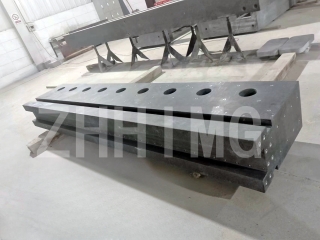In the selection of structural parts, the compressive strength of the material is a crucial consideration. As two common structural materials, precision granite members and precision ceramic members show different characteristics in compressive strength, which have far-reaching influence on the selection and application of structural parts.
Compressive strength comparison
Precision granite components:
Precision granite as a natural stone, its compressive strength is quite high. In general, the compressive strength of granite can reach hundreds of megapascals (MPa) or higher, which makes it perform well under pressure loads. The high compressive strength of granite is mainly due to its dense crystal structure and high hardness, which make granite an indispensable material in heavy structural engineering such as buildings, Bridges and roads.
Precision ceramic components:
In contrast, precision ceramic components also perform well in compressive strength, but the specific value will be affected by factors such as material composition and preparation process. In general, the compressive strength of precision ceramics can reach thousands of megapascals (MPa) or even higher. This high strength is mainly due to the dense crystal structure inside the ceramic material and the strong ionic bond, covalent bond and other chemical bonds. However, it should be noted that although the compressive strength of precision ceramics is high, its tensile strength and shear strength are relatively low, and its brittleness is large, which limits its application in some fields to a certain extent.
Influence on selection of structural parts
Application scenario considerations:
When selecting structural components, you need to know the application scenario and specific requirements. For occasions that need to withstand large pressure loads, such as Bridges, tunnels, high-rise buildings and other heavy structural projects, precision granite components become the first choice because of their high compressive strength and good durability. For some occasions that require high accuracy and stability, such as precision measuring instruments, semiconductor equipment and other fields, precision ceramic components are favored because of their high insulation and low thermal expansion coefficient.
Balance of costs and benefits:
In addition to considering the compressive strength of the material, it is also necessary to comprehensively consider factors such as cost, processing difficulty, and maintenance cost. Although the precision granite component has high compressive strength, it is difficult to process and the cost is relatively high. Although the precision ceramic component has many excellent properties, its preparation process is complicated and the cost is high. Therefore, when choosing structural parts, it is necessary to make trade-offs and trade-offs according to actual needs and economic conditions.
Comparison of comprehensive performance:
In the selection of structural parts, it is also necessary to conduct a comprehensive comparison of the comprehensive properties of the material. In addition to compressive strength, it is also necessary to consider the tensile strength, shear strength, toughness, corrosion resistance, thermal stability and other properties of the material. Precision granite components are excellent in compressive strength and durability, but relatively poor in toughness. Precision ceramic components have excellent insulation, low thermal expansion coefficient and corrosion resistance, but there are some challenges in brittleness and processing difficulty. Therefore, when selecting structural parts, comprehensive consideration and selection should be made according to specific needs.
In summary, precision granite components and precision ceramic components have their own advantages in compressive strength, which has an important impact on the selection of structural components. In practical applications, comprehensive consideration and selection should be made according to specific needs and scenarios to ensure the safety, reliability and economic rationality of structural parts.
Post time: Aug-07-2024

